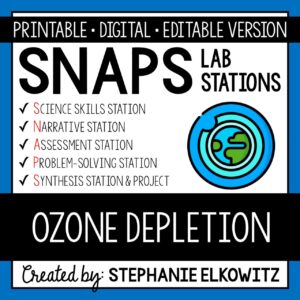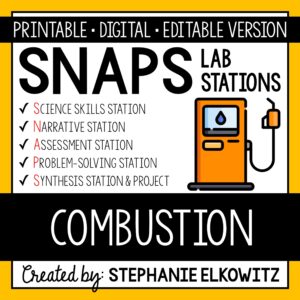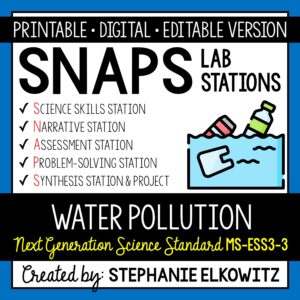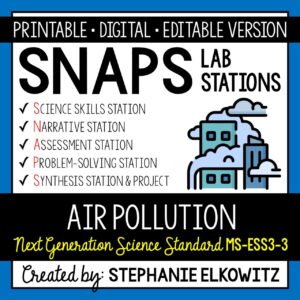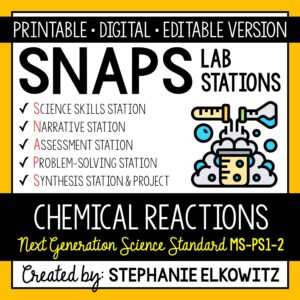Sun, Earth and Moon System Lab
$7.00
An engaging lab activity designed to enhance students’ understanding of the Sun, Earth and moon system.
Description
Sun, Earth and Moon System Lab Preview
SNAPs Lab Stations Activities require students to use science, math, literacy, problem-solving and engineering skills. They are designed to enhance students’ understanding of scientific concepts and help students apply scientific ideas to the real world. Each station activity promotes skills so to develop students into proficient and competent scientific thinkers.
SNAPs lab activities have five components:
• Science Skills Station to develop science skill proficiency
• Narrative Station to build science literacy
• Assessment Station to evaluate learning and understanding
• Problem-Solving Station to foster engineering design
• Synthesis Station and Project to inspire higher-order learning
DIGITAL LABORATORY – DISTANCE LEARNING & DIGITAL CLASSROOMS
• This lab is offered in a digital format to support digital classrooms & distance learning.
• The digital lab activity is designed to work with Google Slides and Microsoft PowerPoint
• The digital lab activity CANNOT be edited. However:
– Students can manipulate text boxes
– Students can create tables, graphs and diagrams
– Students can insert images and drawings
GOOGLE FORM ASSESSMENT STATION
• The assessment station is offered as a self-grading Google Form.
• Questions are all short answer and are 100% editable.
• Suggestions for use are included in the download.
DISTANCE LEARNING COMPATIBILITY
SNAPs lab activities are rated for their ease with distance – independent learning. Refer to the preview for more information about how well this laboratory works in a fully digital classroom and with distance learning.
EDITABLE DOCUMENTS
This download includes an editable word document (docx file) of all lab components:
• Pre-Lab and Post-Lab Activities
• The Lab Overview
• Lab Station Activities and Questions
• Directed Synthesis Project (when applicable)
Important Notes:
• Diagrams, illustrations, tables and graphs essential to lab activities are included
• Illustrative clipart is NOT included
• Editable documents and rubrics are included with the FREE SNAPs Setup Guide
Editable files allow you to:
• Edit the scope of the activities so to suit your students’ needs
• Edit the materials required based on resource availability
• Create single-period “mini-labs” using activities at the individual skills stations
The activities at each station in this lab are detailed below.
Sun, Earth and Moon System Lab Stations Activity Learning Objectives
1. Compare rotation and revolution of celestial bodies.
2. Relate celestial cycles with themotions of the Earth and moon.
3. Create a visual model of the Sun, Earth and moon system.
4. Compare and contrast the geocentric and heliocentric models.
Science Skills Station
In the first activity, students will create a visual model of the Sun, Earth and moon. The visual representation will be drawn to scale using raw data about the size of the celestial objects and the distance between them. In the second activity, students will compare and contrast the motions of the Earth and moon. They will determine the celestial cycles that result from the motions of these objects.
Narrative Station
Students will read about the Sun, Earth and moon at this station. They will read about the motion of these celestial objects and the celestial cycles that result from their motion.
Assessment Station
At this station, students will answer questions about key terms and ideas relating to the Sun, Earth and moon. Students must employ lower, mid and higher order thinking skills to answer these questions.
Problem-Solving Station
Students will study and evaluate the geocentric and heliocentric models at this station. They will identify problems with the geocentric model and original heliocentric model, evaluate improvements made with the heliocentric model and discuss how the models illustrate our changing view of the universe.
Synthesis Station
Students will compose a CER (claim-evidence-reasoning) report to summarize the lab. Students are provided the claim statement and must support the claim with observations, data and other information gathered in the lab. Students will explain how the evidence supports the claim using scientific reasoning.
Synthesis Project
Students will have a choice of 11 projects. Refer to the SNAPs Lab Stations Best Practices and Setup Guide for directions and suggestions on how to conduct the project.
This download includes:
• A pre-lab assignment and post-lab reflection
• Directions and questions for each lab station
• Student recording sheets
• Teacher Key
Additional Materials Required:
Brass fasteners
Ruler
Compass (drawing tool)
Scissors
11 x 17 paper
Construction paper
Single hole puncher
1 Computer or tablet
LINKS TO VIDEOS
This laboratory requires internet to access videos. Videos are hosted on SafeShare.TV so to safely watch and share educational YouTube videos without ads, comments and other distractions. Shortened and full link(s) to SafeShare.TV included. Full link to original YouTube video(s) included.
TERMS OF USE
• All rights reserved by Stephanie Elkowitz.
• This product is to be used by the original purchaser only.
• Intended for classroom and personal use only.
• Copying for more than one teacher, classroom, department, school, or school system is prohibited.
• This product may not be distributed or displayed digitally for public view.
• Failure to comply is a copyright infringement and a violation of the Digital Millennium Copyright Act (DMCA).




